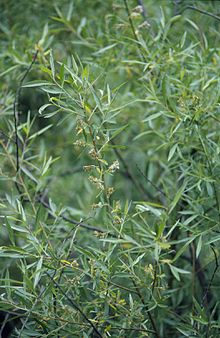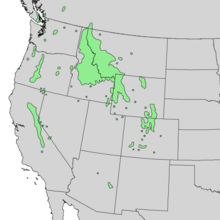| Salix geyeriana | |
|---|---|

| |
| Scientific classification | |
| Kingdom: | Plantae |
| Clade: | Tracheophytes |
| Clade: | Angiosperms |
| Clade: | Eudicots |
| Clade: | Rosids |
| Order: | Malpighiales |
| Family: | Salicaceae |
| Genus: | Salix |
| Species: | S. geyeriana
|
| Binomial name | |
| Salix geyeriana | |
| Hybrids*[3] | |
*Note: only natural hybrids are listed here. | |

| |
| Natural range of Salix geyeriana | |
| Synonyms | |
| |
Salix geyeriana is a species of willow known by the common names Geyer's willow, Geyer willow and silver willow.[5][12] The type specimen was collected by the botanist Karl Andreas Geyer, for whom it was named.[2] Its conspicuous, yellow flowers begin to bloom as early as March, to as late as the end of June.[3][13]
Description[edit]
Salix geyeriana is a shrub growing up to 5 m (16 ft) tall, sometimes forming dense colonial thickets. The leaves are narrowly or widely lance-shaped and may grow over 7 cm long. Young leaves are coated in white or pale silky hairs, and some adult leaves retain their hairy textures. The leaves generally lack stipules or have only vestigial ones. The inflorescence is a spherical or slightly elongated catkin usually not more than about 2 cm long.
This species reproduces sexually by seed, as well as vegetatively, by sprouting from the stem or sections of the stem, which contain early root structures that readily sprout when buried in moist substrate.[12]
Habitat[edit]
S. geyeriana grows in moist and wet habitat types, such as lakesides, riverbanks, and bogs.[3][12]
Distribution[edit]
S. geyeriana is native to western North America. It is distributed from western Canada in southern British Columbia; through the US in Washington; central Idaho; western Montana and Wyoming; eastern Oregon; Nevada; and northern Utah; to southern and western Colorado; through central California; eastern and central Arizona; and western New Mexico. It is found in the Great Basin region, and in the mountains in the High Cascades, the Rockies, the northern and southern High Sierra Nevada, and the San Bernardino Mountains. Populations are especially dense over the Kern Plateau.[3][4][5][12][14]
Hybrids[edit]
The lack of stipules and small, stubby catkins help identify this species; however, it easily hybridizes with many other willows in the wild; the daughter plants differ in morphology.[3]
The most widely distributed natural hybrid is S. geyeriana × S. lemmonii. It is known from British Columbia (in the vicinity of Victoria), Oregon (in Jefferson and Lane counties), and California (in Lassen and Sierra counties).[3]
Hybrids with S. bebbiana are known from Montana (collected from Beaverhead County); those with S. pedicellaris are known from Washington; and those with S. irrorata and S. ligulifolia are known from Arizona.[3][15]
Wildlife value[edit]
S. geyeriana is browsed in the wild by moose (Alces alces) and elk (Cervus canadensis) in all seasons, but is essential during winter.[12]
Grouse (Phasianidae subf. Tetraoninae), ducks (Anatidae), and other small birds, and small mammals regularly consume the buds, catkins, shoots, and leaves of G. geyeriana; and it is one of many Salix species used in the construction of beaver dams for North American beavers (Castor canadensis).[12]
References[edit]
- ^ Stritch, L. (2020). "Salix geyeriana (amended version of 2018 assessment)". IUCN Red List of Threatened Species. 2020: e.T126589461A171684348. doi:10.2305/IUCN.UK.2020-2.RLTS.T126589461A171684348.en. Retrieved 11 April 2024.
- ^ a b S. geyeriana was originally described in two publications during the same year: the Proceedings of the American Academy of Arts and Sciences 4: 63. 1858. (Boston, Massachusetts); and Öfversigt af Konglungen Vetanskaps-Akadamiens Förhandlingar, 15: 125. 1858. (Stockholm, Sweden). "Plant Name Details for Salix geyeriana". IPNI. Retrieved August 29, 2010.
Distribution: Idaho; Collector: C.A.Geyer
- ^ a b c d e f g h "Salix geyeriana". Flora of North America; Vol. 7; pgs 100, 123, 135, 136, 151, 153—156, and 160. eFloras. March 14, 2010. Retrieved August 29, 2010.
- ^ a b George W. Argus (1993). "Jepson Manual treatment for SALIX geyeriana". Jepson Manual Online. University & Jepson Herbaria; Regents of the University of California. Retrieved September 1, 2010.
- ^ a b c "Profile for Salix geyeriana (Geyer willow)". PLANTS Database. USDA, NRCS. Retrieved September 1, 2010.
- ^ S. geyeriana var. argentea was published in Kalmia 13: 29. 1983. "Name - Salix geyeriana subsp. argentea (Bebb) A.E.Murray". Tropicos. Saint Louis, Missouri: Missouri Botanical Garden. Retrieved September 2, 2010.
Annotation: as "Geyerana"
- ^ S. geyeriana var. argentea was published in Notes on American willows X., Journal of the Arnold Arboretum 2: 65-90. 1920. "Google Books page for "Botanical abstracts, Volumes 7-8 By Board of Control of Botanical Abstracts"". 1921. pp. 105–109. Retrieved August 31, 2010.
741. Schneider, Camillo. Notes on American willows X. Jour. Arnold Arboretum 2: 65-90. 1920.—The present article deals with the sections Fulvae and Roscae each containing 3 species, with 2 species of doubtful affinity and a species of the section Glaucae omitted from the treatment of that section. As in the preceding articles the synonymy, nomenclature, distribution and relationship of the species and varieties are discussed at length and the following new combinations proposed: Salix Bebbiana var. perrostrata (Rydb.), S. Geyeriana var. argentea (Bebb), and S. Scouleriana var. Austinae (Bebb). ... —Alfred Rehder.
- ^ S. geyeriana var. meleina was published in Flora of southern British Columbia and Vancouver Island : with many references to Alaska and northern species, 98. 1915. Toronto. "Plant Name Details for Salix geyeriana var. meleina". IPNI. Retrieved August 29, 2010.
Distribution: Vancouver Islands, Shawnigan, British Columbia
- ^ S. macrocarpa Nutt. was published in The North American Sylva 1(2): 67-68. 1842; a homonym of this name, S. macrocarpa Ledeb. ex Trautv., is not a synonym of S. geyeriana. It was published ten years earlier, in Nouveau Mémoires de la Société Impériale des Naturalistes de Moscou 2: 292-293. 1832. "Name - *Salix macrocarpa Nutt". Tropicos. Saint Louis, Missouri: Missouri Botanical Garden. Retrieved September 2, 2010.
Annotation: nom. illeg.
- ^ S. macrocarpa var. argentea was published in Botanical Gazette 10: 223. 1885. "Name - Salix macrocarpa var. argentea Bebb". Tropicos. Saint Louis, Missouri: Missouri Botanical Garden. Retrieved September 2, 2010.
- ^ S. meleina was published in Madroño 6(3): 84. 1941. "Name - Salix meleina (J.K.Henry) G.N.Jones". Tropicos. Saint Louis, Missouri: Missouri Botanical Garden. Retrieved September 2, 2010.
- ^ a b c d e f Uchytil, Ronald J. (1991). "Salix geyeriana". Fire Effects Information System (online). Rocky Mountain Research Station, Fire Sciences Laboratory (Producer): USDA; Forest Service. Retrieved August 29, 2010.
- ^ Wildflower Center Staff (January 1, 2007). "Salix geyeriana (Geyer willow)". Native Plant Information Network. Austin, Texas: Lady Bird Johnson Wildflower Center. Retrieved September 1, 2010.
- ^ "Salix geyeriana". Germplasm Resources Information Network. Agricultural Research Service, United States Department of Agriculture. Retrieved September 1, 2010.
- ^ "Salix bebbiana". Flora of North America; Vol. 7; pgs 25, 57, 99, 119, 121, 127, 130, 133–135, 142, 153. eFloras. March 14, 2010. Retrieved September 2, 2010.
